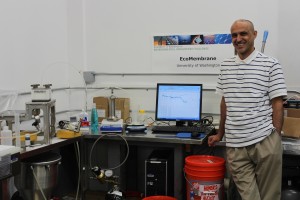
It's no secret that water is essential to our lives. Aside from the daily essentials like drinking or washing, water plays a role in many different industrial processes, whether it be as a solvent, a coolant, a medium for suspension, or in irrigation. Water even finds its way into art with public fountains, water color paints, and ceramic pottery. With so many uses for water, is it any wonder that so many places in the world are starved for it? The problem of increasing water scarcity led Jaffer Alali (pictured on the right) to develop the EcoMembrane as a potential solution and enter it into the University of Washington's (UW) Environmental Innovation Challenge. Hailing from Saudi Arabia, Jaffer knows a thing or two about the difficulty of providing water to an arid region. Before he began the EcoMembrane project at the UW, he spent over 10 years working in seawater treatment at Saudi Aramco and studied environmental engineering at the University of Alabama. The EcoMembrane started with an ordinary reverse osmosis (RO) membrane. What sets the EcoMembrane apart from other RO membranes is the piezoelectric (PZT) ceramic disk that has been attached to it. The PZT disk vibrates at ultrasonic frequencies to form millions of tiny cavitation bubbles in the flow of water to the membrane. The rapid implosion of these bubbles is not enough to disrupt the flow of water through an RO system, but it is sufficient to remove the contaminants that stick to the membrane surface and significantly reduce fouling. The EcoMembrane system's capability to mitigate fouling gives it the potential to greatly reduce the costs associated with RO desalination. It can extend the lifetime of a given membrane, reduce the need for costly pre-treatments, and increase flow rates through a system, all of which provide greater cost efficiency over currently deployed reverse osmosis technology. These features and the growing global market for clean, potable water earned it and Jaffer an Honorable Mention in the UW Environmental Innovation Challenge (the competition is run by the Foster School of Business). Jaffer Alali tested the EcoMembrane and proved his concept right here at Sterlitech Corporation, using the HP4750 stirred cell and CF042 crossflow cell to run his experiments. "The experiment would be almost impossible to run without Sterlitech's equipment because of the heat generated and the pressures required," Jaffer told us, as he recounted his first attempts to test his idea with a system of pressure washers that quickly broke down. He plans to extend the EcoMembrane technology to include hollow fiber filters, which have a much greater surface area than flat sheet membranes but are much more susceptible to fouling.


![Join Sterlitech at BIO 2024 [Booth #5558]: Exploring the Future of Biotechnology](https://www.sterlitech.com/media/magefan_blog/b4.jpeg)

